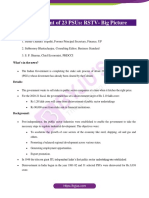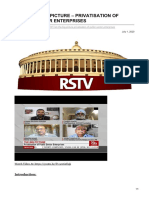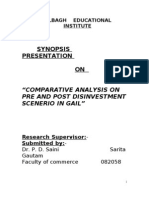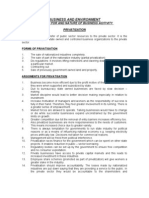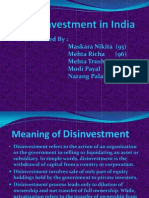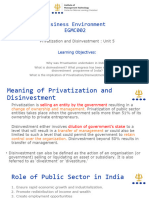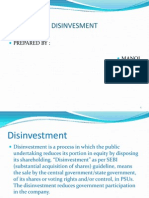Acknowledgemnt: Department of Management, BIT Mesra
Acknowledgemnt: Department of Management, BIT Mesra
Uploaded by
anuj191087Copyright:
Available Formats
Acknowledgemnt: Department of Management, BIT Mesra
Acknowledgemnt: Department of Management, BIT Mesra
Uploaded by
anuj191087Original Title
Copyright
Available Formats
Share this document
Did you find this document useful?
Is this content inappropriate?
Copyright:
Available Formats
Acknowledgemnt: Department of Management, BIT Mesra
Acknowledgemnt: Department of Management, BIT Mesra
Uploaded by
anuj191087Copyright:
Available Formats
DISINVESTMENT IN CIL
ACKNOWLEDGEMnt
Department of Management, BIT Mesra
Page 1
DISINVESTMENT IN CIL
FOREWORD
The basic difference between private and public ownership is the difference in objectives, viz; welfare maximization by the public sector and profit maximization by the private sector. Therefore, there are good reasons for the thinking that the ownership of a firm will have significant effects on its behaviour and performance of an enterprise. Present study is an attempt to analyze the impact of change in the ownership on financial performance of public sector enterprises in general and Coal India Limited in particular. In this study, disinvestment of the government shareholding has been taken as an event and pre disinvestment of various financial parameters for THE HALF YEARLY ENDED (JUNE10) is compared with post disinvestment for THE HALF YEARLY ENDED (DECEMBER10). Our result shows that disinvestment improves the profitability and liquidity position of CIL while it has affected the dividend payout negatively.
Department of Management, BIT Mesra
Page 2
DISINVESTMENT IN CIL
TABLE OF CONTENTS
Department of Management, BIT Mesra
Page 3
DISINVESTMENT IN CIL
INTRODUCTION
ABOUT THE PROJECT: Business research is the process of a systematized effort to gain knowledge. A research comprises of defining and redefining problems ,formulating hypothesis or suggested solutions; collecting ,organising and evaluating data; making deductions and reaching conclusion and at last carefully testing the conclusion whether they fit the formulated hypothesis or not.
This project is undertaken on Disinvestment in COAL INDIA LIMITED a) To develop an understanding of the disinvestment procedure in India in the major public sector units b) To develop an understanding of the major public sector companies like CIL. c) To make a comparative analysis of disinvestment in CIL w.r.t. VSNL. d) To develop an understanding of business research process. e) To understand how and where to implement scientific tools of data representation. The project is carried forward with the help of relevant secondary sources of data from reliable sources like the govt. Website on disinvestment and the the official reports of the company. The data is further analysed with the help of statistical tools of analysis and with the help of the accounting ratios.
The project helped us to develop the proper analysis of data and how to move systematically towards any research problem.
Department of Management, BIT Mesra
Page 4
DISINVESTMENT IN CIL
ABOUT CIL COAL INDIA LIMITED INTRODUCTION Coal is the main source of earning in the country. . . . .A new Coal Distribution Policy has been put in place. . . to make coal accessible to all. . . Coal India has been conferred Navaratna Status /or speedy project implementation...
Excerpts of Address by the President of India to the joint Session of Parliament, 12th February,2009
Coal is the mainstay of India's energy sector and 75 percent of the power generation is currently coal based....
Department of Management, BIT Mesra Page 5
DISINVESTMENT IN CIL
Excerpts of Address by Finance Minister in his Budget Speech2009-10 OVERVIEW: Coal India Limited(CIL) is an Indian state-owned coal company headquartered in Kolkata, West Bengal, India and the world's largest coal miner with revenue exceeding Rs 45,797 Cr or $10.3 billion U.S. (FY2009-10). It is owned entirely by the Union Government of India, under the administrative control of the Ministry of Coal. It is involved in coal mining and production industry.
COAL INDIA LIMITED
Type Industry Founded Headquarters Key people Products Coal Production Revenue Net income Market Share Estimated PBT Employees
State-owned Coal & Lignite 1975 Kolkata, West Bengal, India Partha S Bhattacharyya, (Chairman) Coal 431 mn tones Rs. 45,797 crore (US$10.3 billion) (2009-10) Rs.2,079 crore (US$467.78 million)(2009-10) 82% ~$12.5 bn FYE March 2010 around 400 thousand (March 31, 2010)
Coal India Limited is a public sector undertaking under the administrative control of the Ministry of Coal. The company was incorporated under the Companies Act, 1956 on 21.10.1975. CIL was set up with the objective to produce and market the planned quantity of coal (and coal products) efficiently and economically with due regard to safety, conservation and quality. The paid up capital of the company as on 31.03.2010 is Rs.6316.36 crore divided into 631,63,64,400 shares of face value of Rs. 10 each. Presently, the Government of India (the Government) holds 100% of the paid up equity capital of the company.
Department of Management, BIT Mesra Page 6
DISINVESTMENT IN CIL
CIL operates through 8 wholly owned subsidiaries namely:i) Eastern Coalfields Limited (ECL) ii) Bharat Coking Coal Limited (BCCL) iii) Central Coalfields Limited (CCL), iv) Western Coalfields Limited (WCL), v) South Eastern Coalfields Limited (SECL). vi) Northern Coalfields Limited (NCL), vii) Mahanadi Coalfields Limited (MCL), viii) Central Mine Planning & Design Institute Limited (CMPDIL). The companies at serial (i) to (vii) above are engaged in production and marketing of coal, besides implementing projects for augmenting coal production and/or beneficiation. Since its formation in 1975, the aggregate coal production of CIL has grown from a level of 75 million tonnes to 403.73 million tonnes in 2008-09.
ABOUT DISINVESTMENT DEFINITION: Disinvestment refers to the action of an organization or the government in selling or liquidating an asset or subsidiary. In simple words, disinvestment is the withdrawal of capital from a country or corporation. Some of the salient features of disinvestment are: Disinvestment involves sale of only part of equity holdings held by the government to private investors. Disinvestment process leads only to dilution of ownership and not transfer of full ownership. While, privatization refers to the transfer of ownership from government to private investors
Department of Management, BIT Mesra Page 7
DISINVESTMENT IN CIL
Disinvestment is also called as Partial Privatization. INDIAN SCENARIO: A large number of PSUs were set up across sectors, which have played a significant role in terms of job creation, social welfare, and overall economic growth of the nation; they rose to occupy commanding heights in the economy. Over the years, however, many of the PSU s have failed to sustain their growth amidst growing liberalization and globalization of the Indian economy. Loss of monopoly and a protectionist regime, and rising competition from private sector competitors have seen many of the government-owned enterprises loose their market share drastically. In many instances, many of the PSUs have found themselves unable to match up to the technological prowess and efficiency of private sector rivals, although many have blamed lack of autonomy and government interventions for their plight. Few factors that have prohibited Indian PSUs from performing up to the standards laid down For them at their incorporation include among others: The first order issue is that of competition policy. When the government hinders competition by blocking entry or FDI, this is deeply damaging. Once competitive conditions are ensured, there are, indeed, benefits from shifting labour and capital to more efficient hands through privatisation, but this is a second order issue. The difficulties of governments that run businesses are well-known. PSUs face little "market discipline". There is neither a fear of bankruptcy, nor are there incentives for efficiency and growth. The government is unable to obtain efficiency in utilizing labour and capital; hence the GDP of the country is lowered to the extent that PSUs control labour and capital. When an industry has large PSUs, which are able to sell at low prices because capital is free or because losses are reimbursed by periodic bailouts, investment in that entire industry is contaminated. This was the experience of Japan, where the "zombie firms"- loss-making firms that were artificially rescued by the government contaminate divestment in their industries by charging low prices and forcing down the profit rate of the entire industry. Further, in many areas, the government faces conflicts of interest between a regulatory function and an ownership function. As an example, the Ministry of Petroleum crafts policies which cater for the needs of government as owner, which often diverge from what is best for India. There is a fundamental loss of credibility when a government regulator faces PSUs in its sector: there is mistrust in the minds of private investors, who demand very high rates of return on equity in return for bearing regulatory risk. Then the problem of corruption and misappropriations are all well known in India Thus, privatization was accepted in Indian context.
Department of Management, BIT Mesra
Page 8
DISINVESTMENT IN CIL
TYPES OF DISINVESTMENT There are various types of disinvestment. Some of them are as follows 1.OFFER FOR SALE TO PUBLIC AT FIXED PRICE: In this type of disinvestment, the government holds the sale of the equity shares to the public at large at a pre determined price. Examples:-MFIL, BALCO, CMC, HTL, IBP, HZL, PPL, and IPCL. 2. STRATEGIC SALE: In this type, significant management rights are transferred to the investor i.e. majority of equity holdings are divested. Examples: -Offer of 1 million shares of VSNL, listing of ONGC IPO. 3. INTERNATIONAL OFFERING: This is essentially targeted at the FII (foreign institutionalinvestors). Ex:-GDR of VSNL, MTNL etc. 4. ASSET SALE AND WINDING UP: This is normally resorted to in companies that are eithersick or facing closure. This is done by the process of auction or tender. Ex:-Auction of sickPSUs. OBJECTIVES OF DISINVESTMENT: Privatization intended to achieve the following: Releasing large amount of public resource Reducing the public debt Transfer of Commercial Risk Releasing other tangible and intangible resources Expose the privatized companies to market discipline Wider distribution of wealth Effect on the Capital Market Increase in Economic Activity DISINVESTMENT PROCESS: METHODS ADOPTED IN INDIA The following are the three methods adopted by the Government of India for disinvesting the Public sector undertakings. There are three broad methods involved, which are used in valuation of shares. 1. NET ASSET METHOD: This will indicate the net assets of the enterprise as shown in the books of accounts. It shows the historical value of the assets. It is the cost price less depreciation provided so far on assets. It does not reflect the true position of profitability of the firm as it overlooks the value of intangibles such as goodwill, brands, distribution network and customer relationships which are important to determine the intrinsic value of the enterprise. This model is more suitable in case of liquidation than in case of disinvestment.
Department of Management, BIT Mesra
Page 9
DISINVESTMENT IN CIL
2. PROFIT EARNING CAPACITY VALUE METHOD: The profit earning capacity is generally based on the profits actually earned or anticipated. It values a company on the basis of the underlying assets. This method does not consider or project the future cash flow. 3. DISCOUNTED CASH FLOW METHOD: In this method the future incremental cash flows are forecasted and discounted into present value by applying cost of capital rate. The method indicates the intrinsic value of the firm and this method is considered as superior than other methods as it projects future cash flows and the earning potential of the firm, takes into account intangibles such as brand equity, marketing & distribution network, the level of competition likely to be faced in future, risk factors to which enterprises are exposed as well as value of its core assets. Out of these three methods the discounted cash flow method is used widely though it is the most difficult. LEGAL ISSUES IN THE DISINVESTMENT PROCESS: Legality of the disinvestment process has been challenged on a variety of grounds that slowed the sale of public assets. However, there were two significant judicial rulings that broadly set the boundaries of the D-P process. These are: 1. Privatisation is a policy decision, prerogative of the executive branch of the state; courts would not interfere in it. 2. Privatization of the PSE created by an act of parliament would have to get the Parliamentary approval. While the first ruling gave impetus for strategic sale of many enterprises like Hindustan Zinc, Maruti, and VSNL etc. since 2000, the second ruling stalled the privatization of the petroleum companies, as government was unsure of getting the laws amended in the parliament
ABOUT DISINVESTMENT IN CIL
DISINVESTMENT IN CIL:
In order to facilitate the listing of CIL, the Government considered the disinvestment of 10% paid up equity share capital of CIL comprising of 63,16,36,440 shares out of its holding of 100% through "Initial Public Offer" in the domestic market. One percent (1%) of this public offering reserved for the employees of CIL and its 8 subsidiaries.
Department of Management, BIT Mesra Page 10
DISINVESTMENT IN CIL
ISSUE DETAIL:
OPENING DATE: CLOSING DATE: INSTRUMENT: ISSUE TYPE: FINAL OFFER PRICE(Rs.) %AGE GOVT. EQUITY DIVESTED ISSUE AMOUNT (Rs. CRORE) TIMES SUBSCRIBED 18/10/2010 21/10/2010 EQUITY IPO 232.75 TO 245 10 15,199.44 15.14
OBJECTIVE OF ISSUE:
The objects of the Offer are to carry out the divestment of 631,636,440 Equity Shares by the Selling Shareholder and to achieve the benefits of listing the Equity Shares on the Stock Exchanges. Coal India IPO opened on the 18th of October,2010. The IPO is expected to fetch the government $3 billion, by divesting about 10% of it s stake in this Navratna. The big numbers are not surprising given that Coal India is the biggest coal producer in the world with a production of 431.26 million tons in 2010. Coal India also holds the highest coal reserves in the world, and produced 81.9% of total coal production in India. They had revenues of Rs. 525,922.92 million in 2010, with a profit after tax of Rs. 98,294.09 million in 2010. The Net worth was Rs. 258,437.73 million, cash and bank balances of Rs. 390,777.60 million, and total debt of Rs. 20,868.51 million, and had 397,158 employees.
CHALLENGES THAT COAL INDIA IS LIKELY TO FACE:
Coal India, the world's largest coal miner, on its way to a public listing in India, stated to be the largest-ever in the country. The state-run company is offering 631.6 million shares or 10% of the company that could fetch USD 3.5 billion. The IPO opened on October 18.
Following are some details on Coal India's operations:
Department of Management, BIT Mesra Page 11
DISINVESTMENT IN CIL
Facts and figure:
Coal India was founded in 1973 when the government nationalised many coalmines to boost output under its own supervision. The company made a net profit of Rs 98.337 billion (USD 2.21 billion) in2009/10 (April-March) on revenues of Rs 525.922 billion. A 10% sale for USD 3.5 billion would imply a total value for the company of USD 35 billion with total share capital of Rs 63.16 billion. The company produced 431.26 million tonnes of coal in the year ending March2010, up 6.82% year-on-year. The world's number two coal producer is China's Shenhua Group that is seeing an output of 360 million tonnes in 2010. The monopoly producer accounts for over 80% of India's total coal output and is targeting production of 461.5 million tonnes in the current year which started in April. The company has 471 coal mines, mostly located in eastern and central India, seven subsidiaries and a workforce of 394,041 people. It wants to expand overseas to bridge the yawning gap between India's demand and supply, and is in talks for buying mining stakes in Australia, Indonesia and the United States. Coal India has been importing small amounts of coal and plans to issue a tender for importing 6 million tonnes of coal this year mostly for power-maker NTPC Ltd. The company has a total of 18,862.9 million tons of total reserves of which10, 595.1 million tons are proven. CHALLENGES: Social problems are an obstacle to mine expansion with resistance from locals who are concerned about displacement. Maoists, who say they are opposed to capitalism and have attacked some other staterun firms in east India, are another hindrance to expansion. Bloated stocks of coal because of slow transportation have prompted top officials to consider moving into power generation to use the inventories. Coal India will face competition from foreign miners as the government moves to reform the coal sector and allow non-domestic players to bid for blocks in joint ventures. After selling shares, it will have to review its policy of discounting coal in order to strike a balance between its social obligations to keep power cheap and keeping investors happy with profits and dividends.
SUMMARY OF FINDINGS
Department of Management, BIT Mesra
Page 12
DISINVESTMENT IN CIL
On the basis of half yearly report for year ended june 2010, which is a predisinvestment period and the post disinvestment half yearly report ended December 2010, we can say that after disinvestment gross sale of the company increased by 141.66% which is a good sign for any organisation. Profitability also increased by 17.8% which can be seen as a positive effect of disinvestment but PBIT and PAT of the company has fallen steeply after disinvestment which means the operating efficiency of CIL has declined after disinvestment.
Moreover, the company declared 35% dividend to the shareholders which can be considered good from the shareholders point of view. It will attract more investor towards company in future.
The company being a public sector company, did not pay much attention to marketing policy but now company has gone for disinvestment so it needs to pay some attention to marketing so that it can attract more customers to enhance its sales.
Moreover, there is no significant growth in production capacity of the company but we see a marginal growth in production capacity so we can say that the tangible effect of disinvestment are not yet seen on productivity but we can expect to get exact data in financial report for the year ended March11.
Department of Management, BIT Mesra
Page 13
DISINVESTMENT IN CIL
MAIN REPORT RESEARCH OBJECTIVES : 1. To study the impact of change in ownership (reduction of government ownership) on various financial parameters of public sector companies like Coal India Limited. 2. To study the disinvestment procedure in coal India limited. 3. To compare the performance of enterprise before disinvestment and after disinvestment. 4. To suggest measures for the effective implementation of disinvestment policy in the PSU where disinvestment is about to take place.
Department of Management, BIT Mesra
Page 14
DISINVESTMENT IN CIL
LITERATURE REVIEW 1. PUBLIC SECTOR PERFORMANCE SINCE 1950, A FRESH LOOK -BY: R. NAGARAJ The paper elicits that since the mid-1980s, the public sectors share in domestic investment has been nearly halved, but its output share has remained roughly constant at about a quarter of GDP, suggesting a sustained rise in productivity over nearly two decades. The paper defines three major evidences for the improvement in performance. a rise in physical efficiency in electricity generation a fall in public sector employment growth an increase in central public sector enterprises profitability (even after excluding the petroleum sector) The author then goes ahead to question why then the public sector finances remained adverse. In electricity, passenger road transport and railways the revenue-cost ratio is less than one, and has declined since the early 1990s. Moreover, over the last 40 years, the public sector price deflator declined by 17 percentage points, relative to the GDP deflator. Hence, the author concludes that correct pricing and collecting user charges are probably key to setting public sector finances right. 2. DISINVESTMENT IN INDIA BY: SUDHIR NAIB Twelve years after it was started, the liberalization of the Indian economy remains an ideological and operational battleground. There is mainstream national consensus on the need and irreversibility of reforms, but widespread disagreement about its pace and the sharing of its benefits. A basic aspect of the withdrawal of the state from the economic sphere has been the divestment to private parties of the shares (and in some cases control) of public sector enterprises (PSUs) or state-owned enterprises (SOEs)]. This has affected thousands of Indians, and triggered fierce political debates. The book gives a comprehensive roundup of the why and how of SOE privatization. It provides a perspective on the past, present and future of PSU divestment from someone who has studied the process up close. Before the commentary on the Indian experience, the book touches on the historical development of the idea of private enterprise in public works, and the major theoretical positions on the state versus private ownership debate. It provides a comprehensive review of the disinvestment process followed by India and analyses the impact of performance of the disinvested enterprises.
Department of Management, BIT Mesra Page 15
DISINVESTMENT IN CIL
3. DISINVESTMENT AND PRIVATIZATION IN INDIA, ASSESSMENT AND OPTIONS- BY: R NAGARAJ The author studies close to 250 public sector enterprises (PSEs) owned and managed by the central government, mostly in industry and services (excluding the commercial banks and financial institutions). The study suggests an alternative institutional arrangement for improving PSEs financial performance: mutual stock holding among complementary enterprises tied around a public sector bank to minimize problems of soft budget constraint, dysfunctional legislative and bureaucratic interference, and to encourage close interaction between banks and firms to promote long term economic development. 4. DISINVESTMENT IN INDIA, I LOSE AND YOU GAIN- BY: PRADIP BAIJAL The process of disinvestment in India has been fraught with challenges and controversies. Disinvestment in India: I lose and You Gain, written by one who has been at the centre of all privatization debates and controversies, brings to light the facts that surround the disinvestment story. It underlines the most compelling rationales behind privatization: relief to the taxpayer and the simultaneous need for funds for infrastructure development and social-sector investment. This book traces privatization cycles across the globe through a historical perspective by looking at the privatization models and processes adopted in different countries. It also includes case studies of companies like BALCO, Maruti, Hindustan Zinc, VSNL, Jessop and CMC, providing an insight into the different aspects of disinvestment. This book discusses the impact of privatization and disinvestment on companies, economies and other stakeholders, and serves to initiate a healthy and wellinformed debate on the basis of facts.
Department of Management, BIT Mesra
Page 16
DISINVESTMENT IN CIL
HYPOTHESIS
Assumption: it has been assumed that public sector enterprises are not able to achieve their financial goals due to government fiscal,economical,political and social policies. Thus it is expected that disinvestment would lead to increase in profitability and operating efficiency. THUS THE HYPOTHESIS OF OUR STUDY ARE AS FOLLOWS: (H1)The dilution of government equity in ownership will cause profitability and operating efficiency to improve. For measuring profitability we will compute mean value of Return on Sales Ratio before and after disinvestment period.
ROS > ROS A B
(H2) There will be decrease in the proportion of debt in the capital structure both because of the states withdrawal of debt guarantees and increase in enterprises cost of borrowing. For measuring proportion of debt in capital structure we will compute mean value of Debt to Asset Ratio for before and after disinvestment period. LEVA < LEVB (H3) The dividend payout will increase on disinvestments as private investors would demand higher dividends. For measuring the impact of dilution of government equity on dividends we will compute mean value of Dividend Payout Ratio for before and after disinvestment. PAYOUTA > PAYOUTB (H4) The liquidity will improve. It is expected that sales volume will improve after disinvestment and that will result into higher inventory.
Department of Management, BIT Mesra Page 17
DISINVESTMENT IN CIL
For the measurement of liquidity we will compute Current Asset to Current Liability Ratio for coal india limited before and after disinvestment period. LQTDYA > LQDTYB
METHODS AND METHODOLOGIES:
1. Collection of facts and figures related to disinvestment. 2. Critical analysis of Coal India limited and study of disinvestment in CIL. Here we will be mostly concerned with the secondary data. 3. Critical analysis of financial reports of Coal India limited: a. We will extract the current data related to sales volume of CIL. b. We will then be concerned with the debts and borrowings of CIL. c. We will get the current data related to capital structure of CIL to critically analyse the dividend payment procedure and its current rate and liquidity position. 4. We will go for a generalised analysis of viewpoints of senior officials of CIL, employees of CIL, who invested in CIL and government approach towards disinvestment in CIL after its implementation. . For this we will conduct an informal survey. 5. Now we will go for analysis of final data collected by using the various financial parameters such as mean and accounting ratios. 6. Interpretation of the report by using various statistical tools. Note: Most of the figures and data would be collected from the secondary sources of data after ensuring its reliability and validity.
DATA AND VARIABLES:
For the purpose of the present study Pre- disinvestment mean value of various financial parameters for Financial Years (2009-10) is compared with their Post disinvestment value
Department of Management, BIT Mesra Page 18
DISINVESTMENT IN CIL
for Financial Years (2010-2011). Various financial ratios calculated Pre and Post disinvestment for measuring the financial performance of CIL are as follows: (i) To measure profitability position, Profit before Depreciation, Interest and Taxes to Sales Ratio (PBDIT/ Sales) and Profit after Tax to Sales Ratio(PAT/ Sales); (ii) To measure leverage position, Debt to Assets (Debt/ Total Assets); (iii) To measure liquidity, Current Assets to Current Liability Ratio (Current Assets/ Current Liabilities) and (iv) To measure dividend payout, Dividend Pay Out Ratio (Dividend Paid/ PAT).
DATA ANALYSIS
STRATEGIC ANALYSIS OF COAL INDIA LIMITED
A businesss position within the planning grid is calculated by subjectively quantifying the Two dimensions of the grid. Industry attractiveness factors of CIL Market Share Projected growth Rate 82% 7%
coal production(%)
500 400 300 200 100 0 2010-2011E
2002-2003
2001-2002
2003-2004
2004-2005
2005-2006
2006-2007
2007-2008
2008-2009
Department of Management, BIT Mesra
2009-2010
Page 19
DISINVESTMENT IN CIL
PBT margin%
35% 30% 25% 20% 15% 10% 5% 0%
productivity(tonnes)
5 4 3 2 1 0
The above charts show that there is growth in production, productivity, & PBT margin % but the growth rate is not very satisfactory.
Business Strength for CIL FACTORS Market share ownership Production capacity efficiency WEIGHTS RATING 30 20 5 5 1 0.5 0.75 0.6 SCORE 30 10 3.8 3
Department of Management, BIT Mesra
Page 20
DISINVESTMENT IN CIL
R&D Strategic capabilities marketing Finance total
10 10 10 10 100
.75 .5 0 1 ---
7.5 5 0 10 69.3
Ratings-high=1
medium=0.5
low=0
Coal production and others various related industries in which CIL operates seems to be fairly attractive for it. As far as overall business strength is concerned it is in favor of CIL. It is market leader in coal production and other related industries. There is enough production capacity available with CIL and scope of its expansion is also very good. Finance and Strategic capability of CIL is outstanding. Company is performing fairly well on production efficiency and R&D front. Only areas of concern for the company are its ownership and marketing. Being a public sector company it does not put much effort on the marketing. Majority of its client are financially sick State Electricity Boards (SEBs) and CIL is a preferred supplier to these SEBs because its competitor MNCs are hesitant to supply equipments to these SEBs because of their sick financial position. Its ownership structure also sometime restrain it form cheap foreign financing and cross border joint ventures, which may result into expanded international market for its products. Thus we assume here that dilution of the government ownership in CIL, which is a globally competitive company functioning in fairly attractive industry, would result into improved overall performance.
Department of Management, BIT Mesra
Page 21
DISINVESTMENT IN CIL
RESULT ANALYSIS
Profitability (PBDIT/Sales) before and after disinvestment: Pre disinvestment(quarter ended on sept10) Post disinvestment(quarter ended on dec10) 0.28 0.33
EPS Pre disinvestment(quarter ended on sept10) Post disinvestment(quarter ended on dec10) 4.00 4.20
Test of hypothesis hypothesis Pre disinvestment 0.28 Post disinvestment 0.33 Difference (pre-post) profitability +0.5 accepted Accepted/rejected
Department of Management, BIT Mesra
Page 22
DISINVESTMENT IN CIL
EPS
4.0
4.2
+0.2
accepted
We can not test other 2 hypotheses due to lack of data.CIL will publish its finanacial report for the year ending 31st march 2011 after 60 days.
Profitability:
Hypothesis: ROSA > ROSB Hypothesis is accepted as ROSA ROSB = + 0.50 Profitability after disinvestment has been increased, which is in accordance with our hypothesis. Mean of Return on Sales Ratio for post disinvestment period is significantly higher than the Same ratio for pre disinvestment period.
EPS Hypothesis: EPSA > EPSB Hypothesis is accepted as EPSA - EPSB = +0.2 EPS after disinvestment has been increased, that is again in accordance with our hypothesis.
Department of Management, BIT Mesra
Page 23
DISINVESTMENT IN CIL
COMPARATIVE ANALYSIS OF DISINVESTMENT IN VSNL WITH CIL ANALYSIS OF DISINVESTMENT IN VSNL
RATIO Pre-disinvestment ERA Mean S.D C.V. OPERATING PERFORMANCE BASED ON SALES Gross Profit 52.46 18.18 34.65 Ratio Net Profit Ratio 25.74 7.09 27.54 Operating 52.64 18.58 35.30 Profit Ratio Material Cost 0.26 0.23 88.46 /Net Sales OPERATING PERFORMANCE BASED ON INVESTMENT Return on Total 27.09 7.2 26.73 Assets Return on Net 57.04 11.17 19.58 Capital Employed FINANCIAL STRENGTH Debt Equity 1.48 0.61 41.22 Ratio Proprietary 43.54 9.67 22.21 Ratio Solvency Ratio 56.46 12.51 22.15 Fixed Asset to 51.15 8.84 17.28 Net worth Interest 628.35 957.76 152.42 Department of Management, BIT Mesra Post-disinvestment ERA Mean S.D 33.41 20.69 34.32 26.9 13.96 6.96 13.25 37.07
C.V 41.78 33.64 38.61 137.81
18.75 39.04
6.14 15.33
32.75 39.27
0.83 58.44 41.56 50.18 12434.34
0.59 14.94 15.68 20.45 30328.39
71.08 25.56 37.72 40.75 243.91 Page 24
DISINVESTMENT IN CIL
Coverage Ratio CORPORATE LIQUIDITY Current Ratio 1.82 Liquid Ratio 1.82 ASSET USAGE Inventory 409.65 Turnover Ratio Debtors 1.5 Turnover Ratio Fixed Asset 2.43 Turnover Ratio Working 1.95 Capital Turnover Ratio
0.49 0.49 324.86 0.47 0.21 0.98
26.92 26.92 79.30 31.33 8.64 50.26
1.98 1.98 3483.24 3.43 2.43 2.17
0.62 0.62 3771.58 2.19 1.27 0.67
31.31 31.31 108.28 63.85 52.26 30.88
FINDINGS OF VSNL:
The mean of gross profit, net profit and operating profit ratio have declined after disinvestment in VSNL reason being uncontrollable expenditures in post disinvestment period and use of old methods and techniques of controlling cost and marketing of its product. There is a decline of mean score of debt equity and solvency ratio during post disinvestment period which proves lesser dependence on the outsider funds as compared to shareholders fund. Its a good sign of long term solvency as there is also increase in proprietary ratio. Marginal increase in mean of current and liquid ratio which proves its meeting its current obligation in time. The firm manages well its inventory, fixed assets and working capital but failed to manage debtors. So, disinvestment has impact on financial strength and operating performance of VSNL
ANALYSIS OF DISINVESTMENT IN CIL AND VSNL As seen in VSNL, the mean of net profit, gross profit and operating profit ratio have also declined in CIL reason being the same i.e uncontrollable expenditure in post
Department of Management, BIT Mesra Page 25
DISINVESTMENT IN CIL
disinvestment period. So, we say that it is the major impact of disinvestment. The debt equity & solvency ratio during post disinvestment period declined for CIL also. The reason for this can be assumed as lesser dependence on outside fund as compared to shareholders fund and it is expected that CIL current and liquidity ratio improved marginally, which is a good sign as it is a result of meeting its obligation timely. On the basis of comparative analysis we can say that the effects of disinvestment on CIL can be assumed as normal because the similar effect of disinvestment in VSNL.
SUGGESTION FOR CIL:
After disinvestment there is a marginal increase in the gross profit, productivity and the net profitability in a span of 4 months which is a good sign of growth for the company. This means disinvestment proved to be beneficial for CIL. We would like to suggest some further suggestion to improve its performance: It should pay more attention in increasing its economic activity so that new investor will put their money in privatised PSUs which will bring economic stability. It should pay more attention to its marketing strategies to attract more customers.
Department of Management, BIT Mesra
Page 26
DISINVESTMENT IN CIL
CONCLUSION CONCLUSION:
SUMMARY OF FINDINGS On the basis of half yearly report for year ended june 2010, which is a predisinvestment period and the post disinvestment half yearly report ended December 2010, we can say that after disinvestment gross sale of the company increased by 141.66% which is a good sign for any organisation. Profitability also increased by 17.8% which can be seen as a positive effect of disinvestment but PBIT and PAT of the company has fallen steeply after disinvestment which means the operating efficiency of CIL has declined after disinvestment.
Moreover, the company declared 35% dividend to the shareholders which can be considered good from the shareholders point of view. It will attract more investor towards company in future.
The company being a public sector company, did not pay much attention to marketing policy but now company has gone for disinvestment so it needs to pay some attention to marketing so that it can attract more customers to enhance its sales.
Moreover, there is no significant growth in production capacity of the company but we see a marginal growth in production capacity so we can say that the tangible effect of disinvestment are not yet seen on productivity but we can expect to get exact data in financial report for the year ended March11.
ISSUES IN DISINVETMENT PROCESS :
Loss of public interests - PSUs are resources of the nation. They belong to the people. By selling them to private companies, government is seriously affecting the people's welfare. Fear of foreign control - Selling equities to foreign companies result in serious consequences shifting the nation's wealth, power and control to outsiders.
Department of Management, BIT Mesra Page 27
DISINVESTMENT IN CIL
Issues with workers - The jobs of lakhs of workers in the PSUs will fall in danger by privatization.
Less number of bidders - Even though government plans to disinvest, there are actually less number of people willing to place their bids.
Apart from these, it is the government and not PSUs who receive funds from disinvestment. This raises conflicts between the government and the employment union of the PSU.
IMPACT ON EMPLOYEES:
Significant increase in work load and stress Fear regarding job cuts
Department of Management, BIT Mesra
Page 28
You might also like
- Rera - Know Your RightsDocument34 pagesRera - Know Your RightsKB Translation100% (1)
- LPG Policy of India and Its EffectsDocument15 pagesLPG Policy of India and Its EffectsAsif100% (1)
- DisinvestmentDocument46 pagesDisinvestmentGaurav Shah100% (3)
- The Recording ProcessDocument30 pagesThe Recording ProcesssyuhadaNo ratings yet
- FNCE401v7 Assignment 1Document8 pagesFNCE401v7 Assignment 1David Eaton50% (2)
- Disinvestment: Name Roll NoDocument11 pagesDisinvestment: Name Roll NoHarshad HarneNo ratings yet
- Disinvestment PolicyDocument13 pagesDisinvestment PolicyARYAN GUPTANo ratings yet
- Disinvestment of 23 Psus: Rstv-Big PictureDocument3 pagesDisinvestment of 23 Psus: Rstv-Big PictureAbhishekNo ratings yet
- Disinvestment ProjectDocument10 pagesDisinvestment Projecteshan3950% (6)
- Disinvestment Presentation DhirajDocument28 pagesDisinvestment Presentation DhirajVed ParasharNo ratings yet
- Disinvestment in IndiaDocument32 pagesDisinvestment in IndiaDixita ParmarNo ratings yet
- Types of Disinvestment: Commoditization and SegmentationDocument11 pagesTypes of Disinvestment: Commoditization and SegmentationUpanshu SinghalNo ratings yet
- Disinvestment Process in IndiaDocument11 pagesDisinvestment Process in IndiaRiyaz ShaikNo ratings yet
- PSUDocument8 pagesPSUanon_224758276No ratings yet
- RSTV The Big Picture Privatisation of Public Sector EnterprisesDocument4 pagesRSTV The Big Picture Privatisation of Public Sector EnterprisesAbhishekNo ratings yet
- Disinvestment Policy of IndiaDocument7 pagesDisinvestment Policy of Indiahusain abbasNo ratings yet
- Disinvestment in IndiaDocument19 pagesDisinvestment in IndiaNikita MaskaraNo ratings yet
- Disinvestment Synopsis ImpDocument10 pagesDisinvestment Synopsis ImpSarita GautamNo ratings yet
- DISINVESTMENTDocument6 pagesDISINVESTMENTR SURESH KUMAR IINo ratings yet
- Privatization and Disinvestment: BY: Apala Gupta Garima Soni Minakshi Sinha Shraddha ChapekarDocument39 pagesPrivatization and Disinvestment: BY: Apala Gupta Garima Soni Minakshi Sinha Shraddha ChapekarvinodkumardasNo ratings yet
- Disinvestment Petrochemical Industry: Boon or A BaneDocument7 pagesDisinvestment Petrochemical Industry: Boon or A BanePrachi PawarNo ratings yet
- Economics AssignmentDocument8 pagesEconomics Assignmentchandanprakash30No ratings yet
- Disinvestment and PrivatisationDocument30 pagesDisinvestment and PrivatisationSantosh MashalNo ratings yet
- Disinvestment and PrivatisationDocument40 pagesDisinvestment and Privatisationpiyush909No ratings yet
- Economics Project 2020-2021: By: - G. Kishore Ganapathi Roll Number: - 12410Document22 pagesEconomics Project 2020-2021: By: - G. Kishore Ganapathi Roll Number: - 12410Itisme ItisnotmeNo ratings yet
- DISINVESTMENT Timeline Pros and ConsDocument6 pagesDISINVESTMENT Timeline Pros and ConsAshutosh ThakurNo ratings yet
- Public Sector DisinvestmentDocument33 pagesPublic Sector DisinvestmentChinmay HalpatiNo ratings yet
- Divestment and PrivatisationDocument16 pagesDivestment and Privatisationlali62No ratings yet
- Vision IAS Mains Test 5 2021Document22 pagesVision IAS Mains Test 5 2021Amar GoswamiNo ratings yet
- DISINVESTMENTDocument14 pagesDISINVESTMENTPranita ChavanNo ratings yet
- Chapter - 5 Analysis of Problems and Prospects of DisinvestmentDocument15 pagesChapter - 5 Analysis of Problems and Prospects of Disinvestmentmohd sheerafNo ratings yet
- DisinvestmentDocument4 pagesDisinvestmentsanjaym4898No ratings yet
- Disinvestment Policy in India: Progress and Challenges: ManagementDocument3 pagesDisinvestment Policy in India: Progress and Challenges: ManagementK MNo ratings yet
- PSU and DisinvestmentDocument40 pagesPSU and DisinvestmentPritesh JainNo ratings yet
- Business and Environment - noPWDocument5 pagesBusiness and Environment - noPWcitizendenepal_77No ratings yet
- Economics ProjectDocument12 pagesEconomics ProjectVaishnavi CNo ratings yet
- Submitted By: Maskara Nikita (93) Mehta Richa (96) Mehta Trushi (97) Modi Payal (104) Narang PalakDocument20 pagesSubmitted By: Maskara Nikita (93) Mehta Richa (96) Mehta Trushi (97) Modi Payal (104) Narang PalakNikita MaskaraNo ratings yet
- Disinvestment EFMDocument19 pagesDisinvestment EFMJeetPatelNo ratings yet
- Public Sector Enterprises ReformsDocument28 pagesPublic Sector Enterprises Reformsamit1234No ratings yet
- DocumentDocument7 pagesDocumentnswgtstbifmkmpeccwNo ratings yet
- Unit 5Document16 pagesUnit 5Amisha GargNo ratings yet
- Eco AssignmentDocument9 pagesEco AssignmentJigar ParmarNo ratings yet
- Public Private and Joint SectorsDocument11 pagesPublic Private and Joint SectorskocherlakotapavanNo ratings yet
- Q1 Public Sector UndertakingDocument8 pagesQ1 Public Sector Undertakingpriyanka mehtaNo ratings yet
- Privatisation and Disinvestment in IndiaDocument39 pagesPrivatisation and Disinvestment in Indiagarimasoni80% (5)
- Economics Project 2018Document17 pagesEconomics Project 2018Shashwat SinghNo ratings yet
- Model Answer Key Economics-IiDocument17 pagesModel Answer Key Economics-Iisheetal rajputNo ratings yet
- Public Sector in Indian Economy: Dr. Ajay Kumar AsthanaDocument6 pagesPublic Sector in Indian Economy: Dr. Ajay Kumar Asthanajayasvineet727No ratings yet
- DISINVESTMENTDocument4 pagesDISINVESTMENTARYAN GUPTANo ratings yet
- Dod - Final ReportDocument30 pagesDod - Final ReportRaunak GokhaleNo ratings yet
- Disinvestment Process in IndiaDocument3 pagesDisinvestment Process in IndiaRabi Kumar PatraNo ratings yet
- Privitisation and Disinvestment of PsusDocument11 pagesPrivitisation and Disinvestment of Psusnarasimaa100% (1)
- Session II: Topic - Understanding The Role of National Monetization Pipeline PolicyDocument19 pagesSession II: Topic - Understanding The Role of National Monetization Pipeline Policyicreate. psdNo ratings yet
- Dis InvestmentDocument16 pagesDis Investmentsree.funyanNo ratings yet
- Objective of DisinvestmentDocument9 pagesObjective of Disinvestmentsaketms009No ratings yet
- Privatisation and DisinvestmentDocument10 pagesPrivatisation and DisinvestmentSachin MangutkarNo ratings yet
- Submitted To:: Prof. Shweta KumariDocument30 pagesSubmitted To:: Prof. Shweta KumariHinal TejaniNo ratings yet
- Disinvesment: Prepared By: Manoj Jaymin SumantaDocument26 pagesDisinvesment: Prepared By: Manoj Jaymin SumantaNischal Singh AttriNo ratings yet
- Industrial Policies: 24 September 2015 16:46Document3 pagesIndustrial Policies: 24 September 2015 16:46Rain BarkhaNo ratings yet
- LPG Policy of India and Its EffectsDocument18 pagesLPG Policy of India and Its EffectsFACTS YOU MISSED -हिंदीNo ratings yet
- Privatization in PakistanDocument4 pagesPrivatization in PakistanArshgee100% (1)
- Somaliland: Private Sector-Led Growth and Transformation StrategyFrom EverandSomaliland: Private Sector-Led Growth and Transformation StrategyNo ratings yet
- Form 26AS: Annual Tax Statement Under Section 203AA of The Income Tax Act, 1961Document10 pagesForm 26AS: Annual Tax Statement Under Section 203AA of The Income Tax Act, 1961taxolegalNo ratings yet
- Summer Training Project Report On Client Acquisition: An Imperative Component of Wealth Management Process 'Document62 pagesSummer Training Project Report On Client Acquisition: An Imperative Component of Wealth Management Process 'anil kumar reddyNo ratings yet
- Module 13 - BusCom - Forex. - StudentsDocument13 pagesModule 13 - BusCom - Forex. - StudentsLuisito CorreaNo ratings yet
- Dec Banking (Eng) by AffairsCloudDocument173 pagesDec Banking (Eng) by AffairsCloudreshpradi1996No ratings yet
- Ijreiss 460 31870Document9 pagesIjreiss 460 31870Samuel AnthrayoseNo ratings yet
- MyCRM GuideDocument17 pagesMyCRM GuideNguyen DucNo ratings yet
- Florida Set of Discovery - D. Graham Esq.Document42 pagesFlorida Set of Discovery - D. Graham Esq.winstons2311No ratings yet
- Punjab and Sind Bank and Ors Vs Allied Beverages Cs100800COM455901Document8 pagesPunjab and Sind Bank and Ors Vs Allied Beverages Cs100800COM455901Advocate UtkarshNo ratings yet
- Mar 50223 ADocument40 pagesMar 50223 Awangaskarvishal1234No ratings yet
- Chapter 4 - Recording and Summarizing TransactionsDocument56 pagesChapter 4 - Recording and Summarizing Transactionsshemida60% (5)
- REVENUE MEMORANDUM CIRCULAR NO. 33-2021 Issued On March 3, 2021 AnnouncesDocument1 pageREVENUE MEMORANDUM CIRCULAR NO. 33-2021 Issued On March 3, 2021 AnnouncesHahhanNo ratings yet
- Due Diligence Accounting QuestionnaireDocument6 pagesDue Diligence Accounting QuestionnaireGMJNo ratings yet
- Manufacturing Costs and Inventory Costing: Session 4Document37 pagesManufacturing Costs and Inventory Costing: Session 4MarcoNo ratings yet
- Mou German MX (1) GuyanaDocument11 pagesMou German MX (1) Guyanalianac95No ratings yet
- IS-LM Model - CLOSED ECONOMYDocument41 pagesIS-LM Model - CLOSED ECONOMYExcellino Nehemia LaksonoNo ratings yet
- This Study Resource Was: North South UniversityDocument7 pagesThis Study Resource Was: North South UniversitycsolutionNo ratings yet
- Amc CDPDocument180 pagesAmc CDPStela PatelNo ratings yet
- Financial PlanDocument20 pagesFinancial PlanHarold FilomenoNo ratings yet
- NACH FormDocument2 pagesNACH FormShreyas WaghmareNo ratings yet
- CH 8 Cash RevisionDocument10 pagesCH 8 Cash Revisiondima sinnoNo ratings yet
- Chapter 9 (202201)Document22 pagesChapter 9 (202201)OSAMA MohmeNo ratings yet
- Ghana - Rural BankDocument53 pagesGhana - Rural BankNeerajNo ratings yet
- Chapter 3 Joseph Chan Acc 3202Document7 pagesChapter 3 Joseph Chan Acc 3202Noushin ChowdhuryNo ratings yet
- Accounting For LossesDocument4 pagesAccounting For LossesskmasambongcouncilNo ratings yet
- Accounts 2023 AnsDocument42 pagesAccounts 2023 AnsAshish YadavNo ratings yet
- Request For Bonding And/Or Cancellation of Bond of Accountable Officials and Employees of The Republic of The PhilippinesDocument3 pagesRequest For Bonding And/Or Cancellation of Bond of Accountable Officials and Employees of The Republic of The Philippinesronald bantuganNo ratings yet
- Dividend-Distribution-Policy - Tata MotorsDocument3 pagesDividend-Distribution-Policy - Tata MotorsMaheshNo ratings yet








